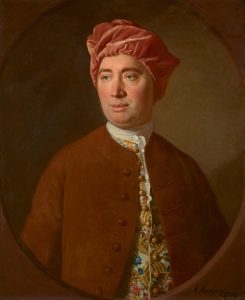
We may never identify the earliest retracted paper. For the time being, this 1756 article about Benjamin Franklin is the earliest one in our database. And here might be a runner-up, of a sort, from a friend of Franklin’s the following year.
David Hume is widely regarded as one of the most influential philosophers of his or any age. His writings on causality, reason, and empiricism, as well as his history of England, were considered masterpieces when they appeared in the 18th century.
In 1757, Hume published a collection of previously released works under the title “Four Dissertations,” which helped – if that’s the right word – cement his reputation as one of the age’s leading skeptics about religion.
Hume wasn’t known for holding his tongue, particularly about Christianity; his abundance of candor cost him academic positions and, occasionally, friendships (both Samuel Johnson and James Boswell decried his lack of piety).
But according to The Infidel and the Professor, a delightful 2017 book by Dennis Rasmussen about the close friendship between Hume and another famous Scottsman, Adam Smith, Hume was not immune to second thoughts. Missing from “Four Dissertations” were two earlier essays in which he’d questioned “the immorality of suicide and the immortality of the soul.”
Evidently, Hume had decided to withdraw the two articles from the collection at the urging of his friends because he feared they would spark outrage from the devout – that is to say, pretty much everyone in positions of authority in that era. In their place he substituted an essay on the less tendentious but non-trivial question of how to measure taste, sure to animate salons but hardly likely to trigger calls for excommunication.
As Rasmussen, a faculty member at Syracuse University, writes:
We do not know what exactly persuaded Hume to retract the essays. In 1772 he recalled having “repented” immediately after sending them to his publisher, declaring that “from my abundant Prudence I suppress’d” these pieces.
Rasmussen notes in the event, Hume’s reputation as a heretic didn’t suffer. How could it with lines like:
Examine the religious principles, which have, in fact, prevailed in the world. You will scarcely be persuaded, that they are any thing but sick men’s dreams: Or perhaps will regard them more as the playsome whimsies of monkies in human shape, than the serious, positive, dogmatic asseverations of a being, who dignifies himself with the name of rational.
Writes Rasmussen:
Once again, then, Hume’s response to a charge of impiety was to set about earning it.
Of course, purists might quibble that Hume’s decision to drop the essays from his new collecting wasn’t technically a retraction – a distinction Rasmussen acknowledged to us in a recent email:
Maybe something like “omit” would have been better. Because … Hume wasn’t disavowing these pieces or saying that they were wrong; he just decided that it would be more prudent to leave them out. That probably doesn’t amount to a retraction in Retraction Watch’s sense.
Perhaps not. But as the great thinker might have said, a thing with multiple potential causes can have the same net effect.
Like Retraction Watch? You can make a tax-deductible contribution to support our work, follow us on Twitter, like us on Facebook, add us to your RSS reader, or subscribe to our daily digest. If you find a retraction that’s not in our database, you can let us know here. For comments or feedback, email us at [email protected].
Maybe put in the Donation of Constantine as a relatively early contender.
The process can be lengthy. The authors did not agree with the retraction.
Post-publication review of the Turin Shroud called for retraction, but again, the institutions just kicked the problem down the road.
In 1389, the image was denounced as a fraud by Bishop Pierre D’Arcis in a letter to the Avignon Antipope Clement VII, mentioning that the image had previously been denounced by his predecessor Henri de Poitiers, who had been concerned that no such image was mentioned in scripture. Bishop D’Arcis continued, “Eventually, after diligent inquiry and examination, he discovered how the said cloth had been cunningly painted, the truth being attested by the artist who had painted it, to wit, that it was a work of human skill and not miraculously wrought or bestowed.” (In German:.[23]) The artist is not named in the letter.[24][25]